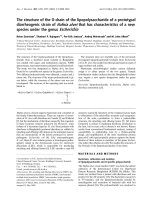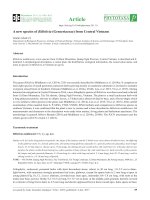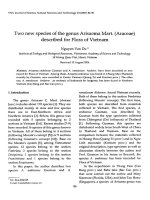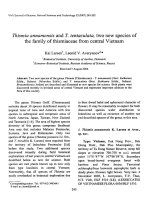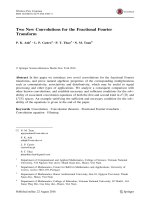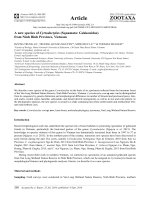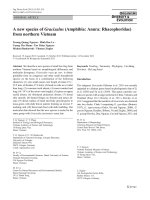Two new species of the genus Ptycholaimellus Cobb, 1920 (Nematoda: Chromadoridae) from coastal zone of North Vietnam sea
Bạn đang xem bản rút gọn của tài liệu. Xem và tải ngay bản đầy đủ của tài liệu tại đây (1.02 MB, 6 trang )
TẠP CHÍ SINH HỌC, 2012, 34(4): 413-418
TWO NEW SPECIES OF THE GENUS PTYCHOLAIMELLUS COBB, 1920
(NEMATODA: CHROMADORIDAE) FROM COASTAL ZONE
OF NORTH VIETNAM SEA
Nguyen Vu Thanh1*, Nguyen Dinh Tu1, Vladimir G. Gagarin2,
Alekcei V. Tchesunov3, Nguyen Thanh Hien1
1
Institute of Ecology and Biological Resources, VAST, *
2
Institute of Inland Water Biology, Russian Academy of Science
3
Moscow State University, Faculty of Biology, Department of Invertebrate Zoology
ABSTRACT: Two new marine nematode species of the family Chromadoridae collected from coastal
zone of North Vietnam sea were described and illustrated are Ptycholaimellus brevisetosus sp. n. and
Ptycholaimellus areniculus sp. n.. The new species P. brevisetosus sp. n. resembles to P. pandispiculatus
(Hopper, 1961) but differs from it by the longer body, absence of somatic and cervical setae, more wide
labial region, longer cephalic setae and longer spicules, and P. areniculus sp. n. resembles to P.
macrodentatus (Timm, 1961) but differs from it by the longer body, relatively shorter cephalic setae,
absence of knob-like swellings at base of dorsal tooth in stoma and presence of small piece in spicular
apparatus of males.
Keywords: Chromadoridae, Ptycholaimellus, free-living marine nematodes, new species, North Vietnam
coastal sea.
INTRODUCTION
taken with a plastic tube.
The fauna of marine nematodes has been
studied recently in Vietnam. At present, this
investigating field on nematode biodiversity is
strongly improved in connection with building
up basic biomonitoring data for water quality
assessment in watershed and wetland
ecosystems along the country’s coatline. This
work is revealed as a part of the project funded
by Vietnam Academy of Science and
Technology (VAST) for study of biodiversity
and free-living nematode fauna of the coast of
Vietnam. The nematode samples were collected
in March 2010 and November 2012. In this
paper two new species of the genus
Ptycholaimellus Cobb, 1920 (Chromadoridae),
Ptycholaimellus brevisetosus sp. n. and
Ptycholaimellus areniculus sp. n., were
described and illustrated.
Sample processing: after washing samples
onto a 40 µm, nematodes were extracted with
Ludox TM-50 (d=1.18). The extraction was
repeated three times (Heip et al., 1985).
Maximum of 200 nematodes were randomly
picked, transferred in anhydrous glycerol and
mounted on slides for identification and
counting.
MATERIALS AND METHODS
Order Chromadorida Chitwood, 1933
Family Chromadoridae Filipjev, 1929
Genus Ptycholaimellus Cobb, 1920
1. Ptycholaimellus brevisetosus sp. n. (Fig.1,
Table 1)
Sample collecting: samples were scraped by
Ponnar grab. Then top 10 cm sediment was
collected by a plastic tube corer (10 cm2) with
three replicates from each site and fixed with
10% hot formalin solution. Additionally,
samples for granulometric analysis were also
Abbreviations used in the text: L = total
body length (µm); a = body length divided by
maximum body width; b = body length divided
by pharyngeal length; c = body length divided
by tail length; c′ = tail length divided by cloacal
or anal body diameter; V (%) = relation of
distance from anterior body end to vulva for
body length in percentage.
DESCRIPTION
Male: body slender, medium size. Cuticle
annulated, thin. Thickness cuticle at middle of
413
Nguyen Vu Thanh et al.
body about 1.0 µm. Lateral fields 6-7 µm wide,
begin at level of stoma and extend to tail middle.
In the beginning lateral fields have no transverse
crosspieces which appear at level of the middle
of oesophagus length. Somatic setae absent. Lips
well developed, isolated from other body. Inner
labial sensillae and outer labial sensillae badly
visible, in shape of small papillae. Cephalic
sensillae in shape of thin setae and being 55-60%
of labial region width. Cheilostoma armed by 12
ribs. In esophastoma one big dorsal tooth, apical
end which hook-like bend and two small
subventral denticles. Knob-like swellings at base
of dorsal tooth absent. Walls of anterior portion
of esophastoma strongly cuticularized and at its
outer dorsal side have rather long apophysis.
Amphidial fovea in shape of transverse split and
situated at lips bases.
Figure 1. Ptycholaimellus brevisetosus sp. n.
A. Entire male; B. Head region; C. Anterior end of body; D. Vulva region;
E. Spicular aparatus; F. Male tail; G. Female tail.
Oesophagus muscular with big basal bulb,
divided at two portions. Basal bulb being 3945% of oesophagus length. Cardia not visible.
Renette baggy-shaped, large. Its length being
50-65% of oesophagus length. Testis one,
anterior, situated to left side of intestine.
Spicules paired, strongly bent ventrally, 1.4-1.6
times as long as cloacal body diameter.
414
Gubernaculums paired, only slightly bent . At
apical end of each gubernaculums are two small
lateral apophysis, covered spicules and also
small hook-like apophysis. Supplements absent.
Tail elongate-conical, gradually narrowing.
Caudal setae absent. Caudal glands and
spinneret well developed. Spinneret finger-like,
10-12 µm long. Females: general appearance
TẠP CHÍ SINH HỌC, 2012, 34(4): 413-418
similar to that of male. Structure of cuticle and
anterior portion of body similar to males.
Gonads didelphic, amphidelphic; ovaries
antidromous, with long bends. Anterior ovary
situated to right side of intestine, posterior
ovary situated to left side of intestine. Vulva of
transverse slit, equatorial, its lips not
cuticularized and not protruding outside the
body counter. Vulvar glands comparatively
small. Both uterus spacious. Spermathecas oval,
20-31 µm diameter. Tail elongate-conical,
gradually narrowing. Caudal glands and
spinneret well developed.
Table 1. Measurements of Ptycholaimellus brevisetosus sp. n. (all measurements in µm, except ratio)
Characteristics
Holotype
♂
L
a
b
c
c’
V%
Labial region width
Cephalic setae length
Oesophagus length
Oesophageal bulb length
Posterior end of oesophagus to vulva
Posterior end of oesophagus to cloaca
Renette length
Vulva to anus
Tail length
Spicule length
Gubernaculum length
1103
18
6.0
10.2
2.8
–
26
15
185
83
–
810
92
–
108
53
32
Type locality and habitat: littoral of North
Vietnam sea, latitude 21o13.476′, longitude
10722.467′. Depth of waters 1.5-2.0 m, sand,
salinity 24‰.
Type material: holotype male, slide number
100/29 and one female paratypes, deposited
at the Nematode Collection, Center of
Parasitology, Institute of Ecology and
Evolution, RAS, Moscow, Russia. Paratypes: 4
males and 5 females deposited at the Nematode
Collection, Institute of Ecology and Biological
Resources, VAST, Hanoi, Vietnam.
Differential diagnosis: the new species
resembles to Ptycholaimellus pandispiculatus
(Hopper, 1961) Wieser & Hopper, 1967, which
was found at coastal of Mexico (Hopper, 1961)
by structure of spicular apparatus, but differs
Paratypes
4 ♂♂
range
1049-1202
17-26
5.4-6.2
10.0-11.2
2.7-4.2
–
26-28
15-16
176-221
72-90
–
738-873
90-113
–
98-115
52-56
32-34
mean
1113
21
5.8
10.6
3.2
–
27
15
195
83
–
811
104
–
107
53
33
6 ♀♀
range
1205-1518
18-26
5.7-6.6
8.9-12.7
3.5-5.1
45.7-52.5
27-29
15-16
187-252
86-112
353-536
–
89-117
500-630
95-180
–
–
mean
1323
22
6.2
10.5
4.3
49.2
28
15
212
94
439
–
105
542
130
–
–
from it by the longer body (in P.
pandispiculatus L = 970-1140 µm vs. L =10491598 in new species), absence of somatic and
cervical setae, more wide labial region (in P.
pandispiculatus labial region 15 µm wide vs.
26-32 µm in new species, longer cephalic setae
(in P. pandispiculatus cephalic setae 6-7 µm
long vs. 15-16 µm in new species) and longer
spicules (in P. pandispiculatus spicules 40 µm
long vs. 52-56 µm in new species).
Etymology: the species name means “long
setae”, “with long setae”.
2. Ptycholaimellus areniculus sp. n. (Fig. 2,
Table 2)
Male: body slender, medium size. Cuticle
annulated, thin. Thickness cuticle at middle of
body 0.7-1.0 µm. Lateral fields 4-5 µm wide,
415
Nguyen Vu Thanh et al.
begin at level of stoma and extend to tail
middle. In the beginning lateral fields have no
transverse crosspieces which appear at level of
the middle of oesophagus length. Somatic setae
absent. Lips well developed, isolated from other
body. Inner labial sensillae and outer labial
sensillae badly visible, in shape of small
papillae. Cephalic sensillae in shape of thin
setae and being 30-33% of labial region width.
Cheilostoma armed by 12 ribs. In esophastoma
one big dorsal tooth, apical end which hook-like
bend, and two small subventral denticles. Knoblike swellings at base of dorsal tooth absent.
Walls of anterior portion of esophastoma
strongly cuticularized and at its outer dorsal side
have long apophysis. Amphidial fovea in shape
of transverse split and situated at lip bases.
Oesophagus muscular with big basal bulb,
divided at two portions. Basal bulb being 3644% of total oesophagus length. Cardia not
visible. Renette baggy-shaped, large. Its length
being 53-65% of oesophagus length.
Figure 2. Ptycholaimellus areniculus sp. n.
A. Spicular apparatus; B. Entire male; C. Head region; D. Anterior end of body;
E. Female tail; F. Vulva region; G. Male tail.
Testis one, anterior, situated to left side of
intestine. Spicules paired, strongly bent
ventrally, 1.5-1.7 times as long as cloacal body
diameter. Gubernaculums paired, only slightly
bent. There is also small, oval, sclerotized piece.
Precloacal supplements absent. Tail elongateconical, gradually narrowing. Caudal glands and
spinneret well developed. Spinneret finger-like,
416
5-6 µm long.
Female: general appearance similar to that
of males. Structure of cuticle and anterior
portion of body similar to males. Gonads
didelphic, amphidelphic; ovaries antidromous
with long bends. Anterior ovary situated to right
side of intestine, posterior ovary situated to left
side of intestine. Vulva a transverse slit,
TẠP CHÍ SINH HỌC, 2012, 34(4): 413-418
equatorial, its lips not cuticularized and not
protruding outside the body counter. Vulvar
glands comparatively small. Both uterus
spacious. Spermathecas oval, 15-21 µm
diameter. Tail elongate-conical, gradually
narrowing. Caudal glands and spinneret well
developed.
Type locality and habitat: littoral of North
Vietnam sea, latitude 21o13.476′, longitude
107o22.467′. Depth of waters 1-2 m, sediment
of sand, salinity 24‰.
Type material: holotype male on slide
number 100/31 deposited at the Nematode
Collection, Center of Parasitology, Institute of
Ecology and Evolution, RAS, Moscow.
Paratypes 9 ♂♂ and 9 ♀♀ deposited at the
Nematode Collection, Institute of Ecology and
Biological Resources, VAST, Hanoi, Vietnam.
Differential diagnosis: the new species
resembles to Ptycholaimellus macrodentatus
(Timm, 1961) Wieser & Hopper, 1967, but
differs from it by the longer body (in P.
macrodentatus ♂♂ L = 621-670 µm, ♀♀ 796823 µm vs. ♂♂ L = 715-882 ♀♀ µm, ♀♀ L =
863-1069 µm in new species), relatively shorter
of cephalic setae (in P. macrodentatus cephalic
setae are equal to width of labial region vs.
length of cephalic setae being 30-33 % of labial
region width in new species), absence of knoblike swellings at base of dorsal tooth and
presence of small oval piece in spicular
apparatus of males (Timm, 1961).
Table 2. Measurements of Ptycholaimellus areniculus sp.n. (all measurements in µm, except ratio)
Characteristics
Holotype
♂
L
a
b
c
c’
V%
Labial region width
Cephalic setae length
Oesophagus length
Oesophageal bulb length
Posterior end of oesophagus to vulva
Posterior end of oesophagus to cloaca
Renette length
Vulva to anus
Tail length
Spicule length
Gubernaculum length
740
23
5.5
10.2
3.2
–
16
6.0
155
47
–
533
92
–
72
36
23
Remarks: Ptycholaimellus macrodentatus
(Timm, 1961) was found and described from
Kenyan coast of Indian Ocean by Muthumbi
and Vincx (1998). However, vermes of this
nematode population differs from vermes of
types nematode population from Bengal Bay by
the longer body (621-670 µm in P.
macrodentatus), relatively shorter of cephalic
Paratypes
9 ♂♂
range
715-882
20-24
4.9-5.8
9.4-13.2
3.0-3.7
–
15-18
6.0-7.0
135-162
47-68
–
533-648
75-120
–
72-88
36-39
20-23
mean
806
22
5.4
10.6
3.4
–
17
6.5
149
62
–
581
89
–
76
38
22
9 ♀♀
range
863-1069
18-27
5.2-6.5
8.8-11.9
3.6-5.4
46.2-50.1
16-19
6.0-7.5
158-176
60-81
248-338
–
79-113
340-461
86-113
–
–
mean
958
24
5.7
10.1
4.7
48.6
18
6.5
168
73
297
–
98
397
96
–
–
setae (8m in P. macrodentatus), absence of
knob-like swellings at the base of dorsal tooth
and presence of small, oval piece in spicular
apparatus of male. With these differentation we
proposed
the
Kenyan
population
of
“P. macrodentatus” is belong to new species:
Ptycholaimellus areniculus sp. n.
Etymology:
the
species
name
means
417
Nguyen Vu Thanh et al.
“sandy”, “from sand”.
Acknowledgements: This
work was
supported by Vietnam Academy Science and
Technology Tecnology Foundation under grants
VAST.ĐL.12/11-12;
VAST.HTQT.NGA
01/2012-2013 and Russian grant RFBR 12-0493002-Viet.
REFERENCES
1. Dashenko, Belogurov, 1984. Morphological
characteristics of the new species
Ptycholaimellus adocius sp. n (Nematoda,
Chromadorida) from Pocet Bay, Japanese
sea. />2. Eskin R. A., Hopper B. E., 1985. Population
dynamics
and
description
of
Ptycholaimellus hibernus n. sp. (Nematode:
Chromadoridae). Journal of Nematology,
17(1): 38-45.
3. Hopper B. E., 1961: Canadian Journal of
Zoology, 39: 359-365.
4. Preben Jensen and Stefen Nehring, 1992.
Review of Ptycholaimellus Cobb, 1913
(Nematoda:
Chromadoridae),
with
description of three species. Zoologia
Scripta, 21(3): 239-245.
5. Muthumbi A. W., Vincx
Hydrobiologia, 364: 119-153.
M.,
1998.
6. Timm R. H., 1961. Proceedings of the
Pakistan Academy of Science, 1(1): 1-88.
7. Wieser W., Hopper B. E., 1967. Marine
nematodes of the east coast of North
Amrerica. I. Florida Bull. Mus. comp. Zool.
Harw, 135(5): 239-344.
8. WoRMS, 2011. Ptycholaimellus Cobb,
1920. In: Deprez, T. et al., 2005.
9. NeMys. World Wide Web electronic
publication. World Register of Marine Species
/>
HAI LOÀI TUYẾN TRÙNG BIỂN MỚI
THUỘC GIỐNG PTYCHOLAIMELLUS COBB, 1920 (NEMATODA:
CHROMADORIDAE) Ở VÙNG BIỂN VEN BỜ MIỀN BẮC VIỆT NAM
Nguyễn Vũ Thanh1*, Nguyễn Đình Tứ1, Vladimir G. Gagarin2,
Alekcei V. Tchesunov3, Nguyễn Thanh Hiền1
1
Viện sinh thái và Tài nguyên sinh vật, Viện Khoa học và Công nghệ Việt Nam
2
Viện Sinh học nước nội địa Borok, Viện Hàn lâm Khoa học Liên bang Nga
3
Trường Đại học tổng hợp Lômonosov, Moskva. Liên bang Nga
TÓM TẮT
Mô tả và công bố hai loài mới tuyến trùng biển sống tự do Ptycholaimellus brevisetosus sp. n. và
Ptycholaimellus areniculus sp. n. thuộc họ Chromadoridae ở vùng nước ven bờ các tỉnh phía Bắc Việt Nam.
Về hình thái, loài tuyến trùng biển mới Ptycholaimellus brevisetosus sp. n. tương đối giống với loài
Ptycholaimellus pandispiculatus (Hopper, 1961) nhưng có đặc điểm khác ở chỗ cơ thể dài hơn, không có các
lông somatic trên cơ thể và không có lông trên vùng cổ, đường kính vùng môi rộng hơn, lông đầu dài hơn và
gai sinh dục cũng dài hơn.
Loài tuyến trùng biển mới Ptycholaimellus areniculus sp. n. về hình thái tương đối giống loài
Ptycholaimellus macrodentatus (Timm, 1961) nhưng có đặc điểm khác ở chỗ cơ thể dài hơn, lông đầu ngắn,
trong xoang miệng ở phần gốc răng lưng không có đoạn phình lên giống kiểu dạng gốc kim hút và có sự hiện
diện của miếng nhỏ dài trên bộ phận gai sinh dục.
Từ khóa: Chromadoridae, Ptycholaimel, loài mới, tuyến trùng biển, Bắc Việt Nam.
Ngày nhận bài: 19-6-2012
418
